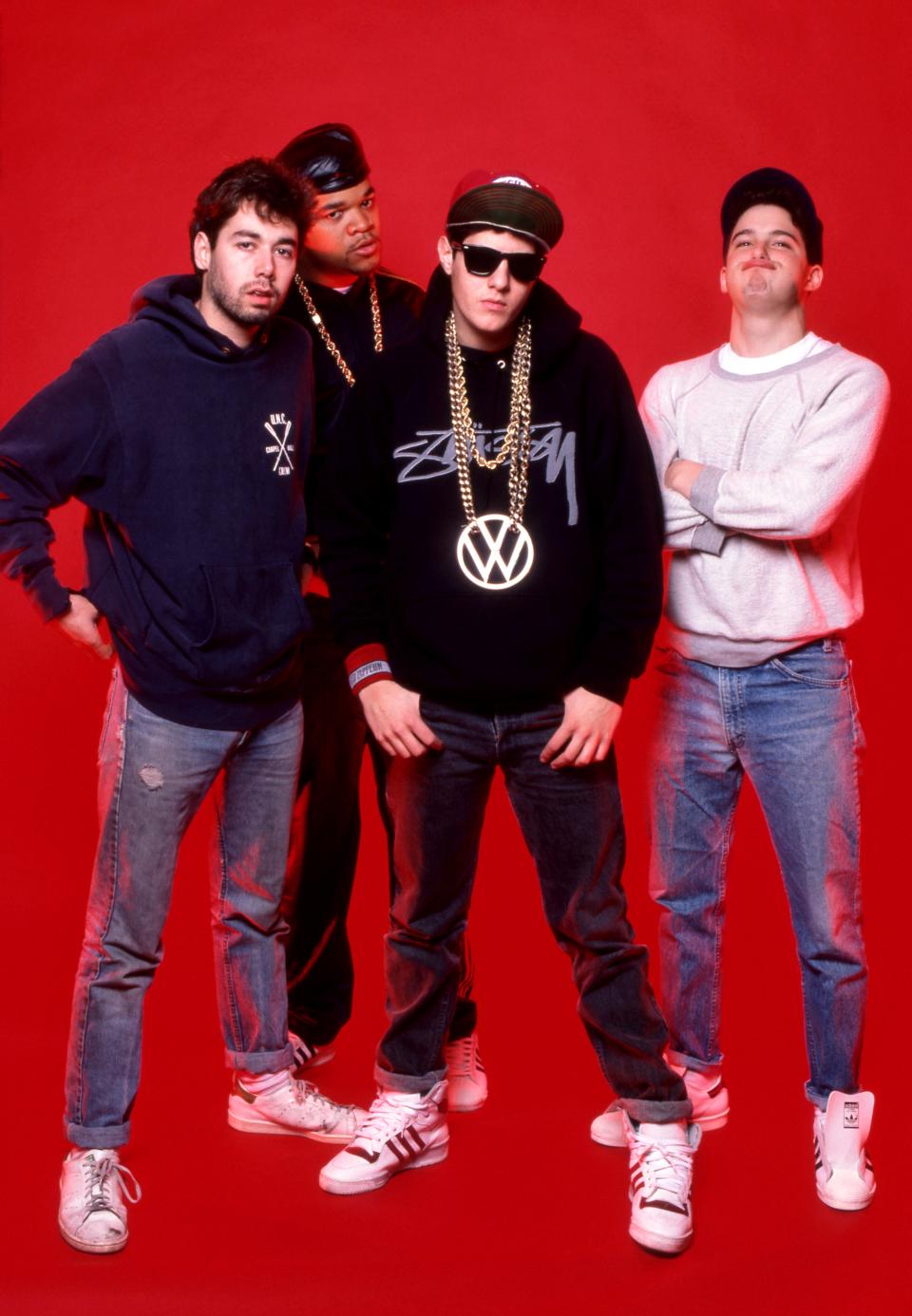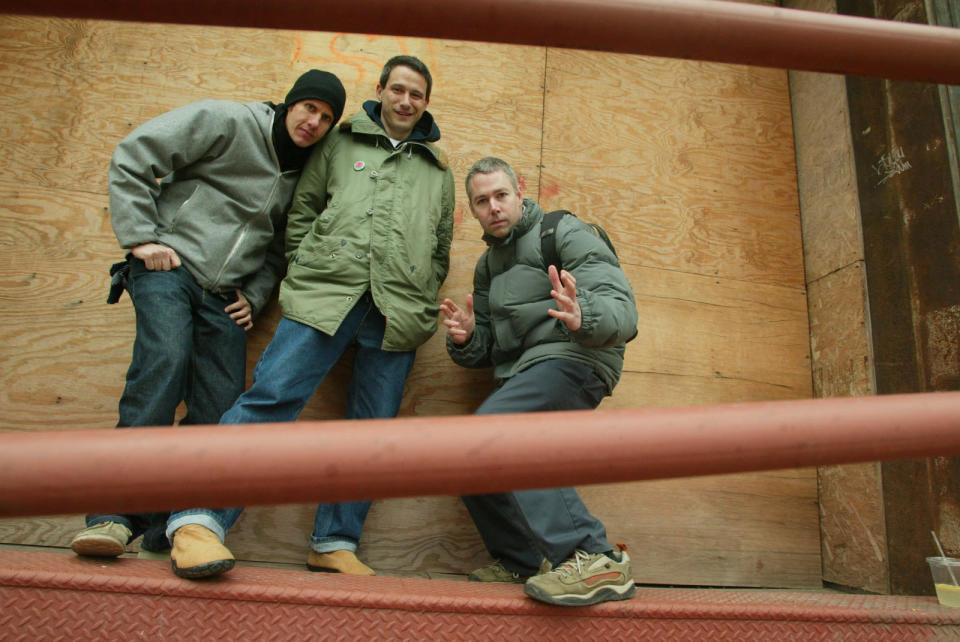No One Had a Style Evolution Quite Like Beastie Boys
It has been a big month for throwback style. GQ has spent the past few weeks documenting the most stylish moments of The Last Dance, ESPN's ode to Michael Jordan and the late-1990s Chicago Bulls. However, there is another recently released documentary that is just as packed with excellent fits and next-level style: the Spike Jonze-directed Beastie Boys Story. That group was best known for its experimental blending of hip-hop, hardcore punk, and everything in between. But the film shows that their sense of style was much like their music—a hodgepodge of motifs from various cultures and scenes. It's the type of thing that doesn't make sense on paper, but the end result is an idiosyncratic style that now feels years ahead of its time—literally, if you look at the dozens of contemporary musicians biting their style today.
The story of Beastie Boys—comprised of Michael "Mike D" Diamond, Adam "MCA" Yauch, and Adam "Ad-Rock" Horovitz; no “the” in the name—begins in the early 1980s when the group was mainly a small-time hardcore band. There is a memorable photo of a teenage Adam Yauch, dressed in skinny jeans, combat boots, and a trench coat adorned with homemade buttons. He looks like a classic punk; the rest of the crew dressed in a similar style. In years to follow, as the band's music started to embrace more elements of hip-hop, their style did, too.
An eye-catching promotional shot from the decade shows the trio in high-top basketball sneakers and puffy overcoats. But I'd be remiss not to mention the outlandish accessories: fur hats, snowboard goggles, big running-style glasses—and a pistol. (Mike D. even had a Stüssy hoodie in frequent rotation at the time.) This look would continue for the rest of the decade, a kind of standard-issue relaxed New York City style with a splash of hip-hop: gold chains and black fedoras, motifs undoubtedly inspired by one of the group's idols, Run DMC. In the documentary, the three Beasties mention studying the iconic group's photos as much as their music, even going as far as to jot down the exact sneaker styles they wore. Their attention-grabbing style coincided with the release of their debut album Licensed to Ill. This record (and in particular, the song "Fight for Your Right") would catapult the band from a local act to a worldwide phenomenon. A bunch of goofy, punk rock Jewish kids from New York City and Brooklyn who dressed like the rap stars they were (their debut album topped the Billboard album chart) was an improbable sight and made their showy style all the more captivating.

The Beastie Boys Portrait Session
The next decade brought a shift in both sound and style. The group released the more artistically mature albums like Paul's Boutique and Check Your Head and their sense of fashion evolved to match. Both albums revealed Beastie Boys to be skilled musicians who pulled obscure samples and explored niche genres. The trio’s ambitious attitude would also extend to their look, too. Instead of bold chains and matching tracksuits, a grunge and punk-inspired look emerged. (With a bit of Beastie Boys flair, of course.) This mostly meant unbuttoned flannels over graphic tees, ratty cardigan sweaters, and plain blue jeans. But Diamond, Horovitz, and Yauch never forgot their roots. Yauch would still wear shirts from the seminal hardcore band Bad Brains, while the group also continued to wear the freshest Adidas sneakers and oversized work jackets, both nods to East Coast hip-hop. It was almost as if these motifs were like song samples, little moments sprinkled into their wardrobes as a wink-wink to those in the known.

Beastie Boys at Universal Amphitheatre 1992
The 2000s brought a more adult version of the group—proving, at least, that “mature Beastie Boys” wasn’t an oxymoron. The three musicians were older now, hair starting to grey in places, and they seemed to settle into their own grown-up style, less reliant on flashy pieces. This meant oxford shirts and work pants; simple hoodies and denim. The group still knew when to pull out the ostentatious style of yesteryear, like when they showed up to the 2004 MTV Awards in matching yellow-and-green tracksuits. But their everyday attire skewed much more casual: this was just how you dressed after you’d become the elder statesman of experimental hip-hop.
In watching the documentary and looking at old Beastie Boys photos, it was surprising to see the band’s now-obvious influence on all sorts of different subcultures and music scenes. While in London in 1993, Mike D wore a pair of what we now know as clout goggles, some 24 years before the oversized shades took over streetwear in 2017. (What a time!) Ad-Rock was photographed wearing a BAPE t-shirt in 1998 while the band toured Portugal. Yauch wore skatewear and Carhartt jackets all throughout the 1990s, long before the workwear company would open a streetwear spinoff store in SoHo. Today, musicians like Lil Uzi Vert and Mac DeMarco may not seem to have a lot of common sartorial ground—but both have pulled style moves that Beastie Boys had been doing decades ago. Beastie Boys were a sort of style Venn diagram—hype kids on one side, weirdos on the other, pulling from (and influencing) both worlds equally. What could be a stronger legacy?

THE BEASTIE BOYS in New York City, left to right: Mike Diamond, Adam Horovitz and Adam Yauch.
Gary FriedmanBeastie Boys embraced an "anything goes'' approach to fashion long before it was cool to do so. The group rose to fame in an era of music that was reliant on the heavy guiding hand of major labels: Rappers were supposed to look like rappers and rock stars were supposed to look like rock stars. (This was also decades before rappers had fully replaced rock stars, and every celebrity had a stylist to tell them what is cool and what isn't.) It feels a little sacrilegious to be praising such talented songwriters for their style and not music. Still, I think Beastie Boys knew the power that clothing could wield in terms of creative expression. There is a studio photo of the group taken in the early 1990s by famed photographer Matthew Rolston. Yauch is wearing a wine-red Champion hoodie with slouchy brown pants; Diamond, with gelled-up bleached hair, wears pastel yellow pants and red clout goggles; Horovitz is in a burnt orange knitted shirt, trousers, and Clark Wallabee boots. All three Beasties are wearing drastically unique outfits yet the colors and composition of the photo is harmonious. It seems symbolic of the group’s underlying chemistry, three individualistic guys who came together to leave a lasting mark on music and fashion, without taking either of those things too seriously. And that was the fun of it.
Originally Appeared on GQ

